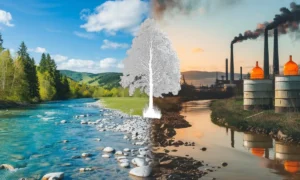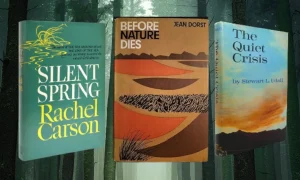Understanding Earth’s Environment – An Overview

The term ‘Environment’ has been derived from the French word ‘Environner,’ which means to surround or to encircle. Environment refers to everything that surrounds us, living or non-living.
In this overview, we will discuss and explore Earth’s Environment briefly.
There are two main types of environment;
Abiotic: the physical things like air, water, and land (we call this the physical environment), and
biotic environment all living things like plants, animals, and tiny organisms (we call this the living environment).
Components of Environment
Earth’s environment can be further subdivided into the following four components:
- Atmosphere
- Hydrosphere
- Lithosphere
- Biosphere
Atmosphere
The air around our planet is like a thin blanket called the atmosphere, made up of different gases.
Atmosphere contains the air that we breathe. It is known as the protective layer of Earth, sheltering life in biosphere, keeping temperatures in balance, and blocking harmful rays from Sun in reaching land.
The main gases in the atmosphere of the Earth are nitrogen, oxygen, and argon. Carbon dioxide is also present with traces of other gases. The atmospheric composition sees a 78% nitrogen, 21% oxygen, 0.9% argon, and 0.1 percent other gases.
100 km above the sea level is the area where most of the atmospheric mass is confined.
There are also the presence of some special gases like ozone and water vapor.
| Layer | Altitude Range | Composition | Temperature Range (°C) |
|---|---|---|---|
| Troposphere | 0-11 km | Mostly nitrogen and oxygen, with trace amounts of other gases. Majority of Earth’s mass and water vapor found here. | Decreases with altitude, ranging from around 15°C at surface to -56.5°C at tropopause |
| Stratosphere | 11-50 km | Contains ozone layer, absorbs UV radiation and warms with altitude. | Increases with altitude, ranging from -56.5°C at tropopause to -2.5°C at stratopause |
| Mesosphere | 50-85 km | Coldest temperatures, meteors burn up here, thin atmosphere. | Decreases with altitude, ranging from -2.5°C at stratopause to -90°C at mesopause |
| Thermosphere | 85-600 km | Temperatures increase with altitude due to solar radiation. | Increases with altitude, ranging from -90°C at mesopause to 12,00°C at upper regions |
| Exosphere | 600 km+ | Blends with outer space, low gravity allows gas molecules to escape into space. | Vary widely depending on solar activity, reaching temperatures as high as 2,000°C |
The atmospheric gaseous composition sees changes due to sunlight and human activities.
Some of the gases in the atmosphere, like carbon dioxide, methane, and nitrous oxide, trap heat and are called “Greenhouse Gases.”
The ‘Greenhouse Effect’ is responsible for keeping the Earth warm. There are also tiny particles and clouds in the air called aerosols, influencing the Earth’s climate.
The atmosphere is divided into layers, starting with the troposphere at the bottom and going up to the stratosphere.
Starting from the bottom is the troposphere where weather happens. Above that is the stratosphere where airplanes fly and the ozone layer protects us from the sun’s deadly rays.
Then there’s the mesosphere and thermosphere, which are higher up and are really hot.
The top layer is the exosphere.
Different Layers of Atmosphere
Earth’s atmosphere is divided into different layers. These layers, moving upward from the ground level, are named the troposphere, stratosphere, mesosphere, thermosphere, and exosphere.

Each layer has its own characteristics and functions important for supporting life on Earth.
Troposphere
The troposphere is the lowest layer where weather processes occur. It is the layer of air (that we breath) closest to the Earth’s surface.
It extends up to about 7-10 km at the poles and 17-18 km near the equator.
As you go higher up, it gets colder. At sea level, it’s about 15°C, but at around 11,000 meters up, it’s a chilly with temperature reaching the freezing levels of -56.5°C!
The air moves around a lot, mixing everything up, except for water vapor, which mostly stays low.
This layer in the atmosphere is where Earth’s most weather happens. The tropopause is the border between the troposphere and the next layer, the stratosphere.
Stratosphere
Above the troposphere lies the stratosphere, which contains the ozone layer.
It extends up to about 50 km.
The stratosphere plays a vital role in protecting life on Earth by absorbing harmful UV radiation emitted from the Sun.
It gets warmer as you go higher up, reaching about -2.5°C at 50,000 meters above sea level. The layer of ozone, a special gas, is found more between 20 and 30 kilometers up, in the “ozone layer.”
Ozone absorbs heat from the sun, making stratosphere warmer.
Mesosphere
The top of the stratosphere is called the stratopause, and it’s where the stratosphere ends and the next layer, called the mesosphere, begins.
The mesosphere reaches temperatures as low as -90°C.
The mesosphere is the layer above the stratosphere, and it gets colder as you go higher up. At around 90,000 meters up, the temperature is about -90°C, making it the coldest layer of the atmosphere.
Meteorites burn up in this layer upon entering the atmosphere from outer space.
The top of the mesosphere is called the mesopause, and it’s where the mesosphere ends and the next layer, called the thermosphere, begins.
Thermosphere
The thermosphere is the part of the atmosphere above the mesosphere and experiences a temperature increase with height.
It gets hotter as you go higher, but there aren’t a lot of air molecules there. It gets thinner as you get closer to space so one wouldn’t feel the temperature as much as space doesn’t carry heat.
Exosphere
The outermost layer of the Earth’s atmosphere is the exosphere.
It gradually transitions into outer space.
The exosphere layer of atmosphere contains mainly oxygen and hydrogen atoms that rarely collide.
Hydrosphere
Water on Earth is divided into two main types: fresh water (like in rivers and lakes) and salty water (in oceans and seas). All the water we have, whether on the surface or underground, is part of fresh and salty water systems.
Oceans, which make up 70% of the Earth’s surface, act as giant storage tanks for both energy and a carbon dioxide reservoirs.
The movement and transport of water in the oceans is much slower than the air in the atmosphere.
Oceans also act like a big thermostat for Earth’s climate. Normally, they take a long time to warm up or cool down.
The water in the oceans and seas is too salty for human-consumption, use in our homes, for farming, or in industries.
Only a small amount of water on Earth, less than 1% (termed fresh water), is suitable for human use.
Water is a common substance in nature, but it has some very special qualities. It has the ability to expand in a unique way. It is a necessity for life on land.
Lithosphere
The Earth’s outer layer is called the lithosphere.
Lithosphere is made up of soil and rocks. Soil contains both living and non-living; minerals and water, as well as microorganisms.
The main soil constitutes come from elements of silicon, calcium, potassium, aluminum, iron, manganese, titanium, oxygen, and more.
These elements combine to form compounds like oxides, silicates, and carbonates.
In addition to these, there are also organic materials in the soil. For example, sugars and compounds containing nitrogen, phosphorus, and sulfur.
Even though these organic materials only make up a small part (about 4%-6%) of the soil, they play an essential role in making the soil fertile and productive for plants to grow.
Biosphere
The biosphere is the protective bubble around the Earth where all living things exist.
It’s because of the Biosphere that Earth supports the ‘Life-Support System’.
Biosphere extends from deep in the ocean to high in the sky. Nothing can survive in normal settings outside of this bubble.
The biosphere includes parts of the Earth including land, water, and air. Humans get the food, water, and oxygen from the biosphere.
Biosphere is showing sign of stress in sustaining itself because of human activities. Atmospheric pollution, ozone depletion, climate change and changes in natural ecosystems all have diverse negative influences on the biosphere affecting living beings.
Interaction among Components
On Earth, everything—from chemicals to living things—is spread out among four main parts: the land (Lithosphere), water (Hydrosphere), air (Atmosphere), and all living beings (Biosphere).
These parts are always interacting with each other. They interact mostly in the form of mass and energy sharing.
Interaction among Environmental Components
Imagine everything around us, air, land, and water etc, are different parts of a big interconnected system. In this system, there’s a constant exchange of matter (such as mass and energy) between these parts.
Let’s take acid rain as an example.
When we release certain pollutants into the air, like sulfur and nitrogen, they can travel to distances carried by the wind.
When it rains, these pollutants would come down with the pouring-in rain droplets, harming crops, land, and living things.
This doesn’t just affect the place where the pollutants were released into the air. These pollution travel far and beyond making the natural rainfall systems in other areas acidic in nature.
Another example can be of that carbon dioxide, a gas we released into the air in high amount due to burning fuels.
Now, industrial zones would be responsible for major carbon dioxide releases in the air. But due to air spreading it in wider atmosphere, the gas has become the main cause of global warming.
The temperature rise in Earth’s overall equilibrium means all Earth’s ecosytems get affected.
That explains how Earth’s environment in the complex of inter-connected systems where one part affected assert impacts on everything else.






